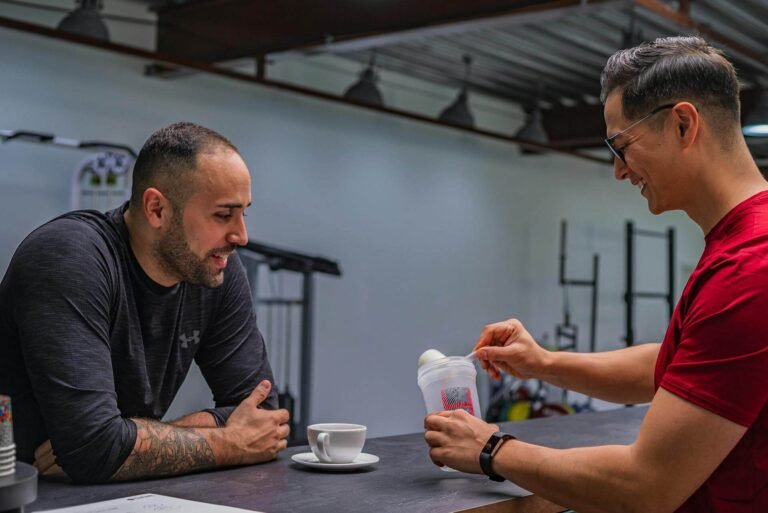
Title: How to Measure Progress Without Relying on the Scale: Your Journey to True Transformation
Introduction
We’ve all experienced that nerve-wracking moment of stepping on the scale, expecting to see a lower number. But what happens when it doesn’t budge or even goes up? Frustration and disappointment often follow. Many of us allow that single number to dictate our emotions and self-worth. However, using only the scale to track progress can be misleading and unfulfilling.
Your body is transforming in ways that the scale simply cannot measure. It’s time to shift focus to more holistic, fulfilling methods of tracking progress that honor all the hard work you’ve put in. Let’s dive deep into ten alternative ways to measure your success on this journey to becoming healthier, stronger, and more confident.
1. Why the Scale is Misleading: Understanding the Bigger Picture
The scale measures your total body weight, but that number doesn’t distinguish between muscle, fat, water, or even bone density. Here’s why relying solely on the scale can be a mistake:
- Fluctuations Due to Water Weight: Water retention can cause significant weight fluctuations. Factors like high salt intake, menstruation, or dehydration can all impact your weight without reflecting actual changes in body fat.
- Muscle Gain vs. Fat Loss: When you start working out, especially strength training, you may gain muscle while losing fat. Muscle is denser than fat, so your weight might stay the same or even increase, even though your body composition is improving.
- Mental Impact: Obsessing over the number can lead to discouragement and affect your motivation. It’s easy to feel like you’re not making progress when, in reality, you’re making incredible strides in strength, fitness, and health.
The Bottom Line: The scale gives you only a small snapshot of your progress. To truly see your transformation, you need a broader perspective.
2. Body Measurements: A Precise Way to Track Physical Changes
Taking measurements of key areas of your body is a more accurate way to monitor changes. This method provides insight into where you are losing inches and gaining muscle.
How to Take Accurate Body Measurements:
- Waist: Place the measuring tape around the narrowest part of your waist, usually right above the belly button.
- Hips: Measure the widest part of your hips and buttocks.
- Thighs: Measure around the fullest part of each thigh.
- Upper Arms: Measure around the midpoint of your upper arm between the shoulder and elbow.
Tips:
- Use the same measuring tape each time for consistency.
- Measure in the morning, ideally before eating or drinking, to avoid bloating.
Tracking Your Progress:
Record your measurements every two to four weeks and compare them over time. Even if the scale isn’t moving, you might notice your waist is getting smaller, indicating fat loss and a healthier body composition.

3. Progress Photos: See the Changes the Scale Can’t Show
Taking progress photos can be one of the most motivational tools on your journey. The changes in your appearance might be subtle day by day, but when you compare photos from a few months apart, the differences can be astonishing.
How to Take Effective Progress Photos:
- Consistency: Wear similar, fitted clothing each time to accurately see your body’s changes.
- Angles: Take photos from the front, side, and back.
- Lighting: Stand in natural lighting for the most accurate comparison.
- Frequency: Take new photos every four weeks to track visible changes.
The Emotional Impact: Progress photos can provide a visual reminder of how far you’ve come. They often capture changes in muscle definition, posture, and body shape that the scale overlooks.
4. Monitor Strength and Endurance Gains: Focus on What Your Body Can Do
When you begin a fitness journey, one of the most rewarding aspects is noticing how much stronger you’re getting. Tracking your improvements in strength and endurance is a great way to measure progress.
Strength Gains:
- Track Weightlifting Progress: Record how much weight you can lift and the number of repetitions you can perform. Increasing these over time shows significant progress, even if the scale doesn’t move.
- Bodyweight Exercises: Count how many push-ups, squats, or burpees you can do. Notice how this number increases with consistent training.
Endurance Improvements:
- Cardio Performance: Record your running or cycling times. As you progress, you’ll notice you can go longer and faster.
- Workout Recovery: Pay attention to how quickly you recover between sets or after workouts. Improved recovery time is a sign of increased fitness.
Celebrating Wins: Every time you add more weight to your lifts, run a bit faster, or complete a workout without stopping, celebrate it as a victory. These gains reflect the improvements in your fitness and overall health.
5. The Fit of Your Clothes: A Simple Yet Effective Indicator
How your clothes fit is one of the simplest ways to notice changes in your body composition. Often, even when the scale doesn’t show a decrease, your jeans may feel looser or your shirt less snug.
Test the Fit of Specific Clothing:
- Choose a pair of pants or a dress that feels a bit tight.
- Try it on every few weeks to assess how it fits.
- Pay attention to areas where the fabric feels looser or more comfortable.
The Confidence Boost: Feeling more comfortable and confident in your clothes can be a powerful indicator of your progress, reminding you that your efforts are paying off.

6. Notice Your Energy Levels and Mood: Inner Transformation Matters
Improved energy levels and mood are often the first signs that your new lifestyle is making a positive impact. Here’s what to look for:
Signs of Improvement:
- Increased Energy: You feel less tired throughout the day and more energized to take on tasks.
- Better Sleep: You fall asleep faster and wake up feeling more rested.
- Improved Mood: You feel less stressed, more positive, and have a clearer mind.
These changes might seem small, but they are significant indicators of your body’s adaptation to a healthier lifestyle.
7. Health Metrics: Monitor Vital Health Indicators
Tracking key health metrics is an excellent way to gauge improvements in your physical health. Consider checking the following:
- Blood Pressure: Regular exercise and healthy eating can help reduce blood pressure over time.
- Resting Heart Rate: A lower resting heart rate indicates improved cardiovascular fitness.
- Cholesterol and Blood Sugar Levels: Regular check-ups can help monitor how lifestyle changes impact your health.
These metrics can reveal significant improvements in your health, even if the scale doesn’t move.
8. Non-Scale Victories (NSVs): Celebrating Every Achievement
NSVs are milestones that aren’t related to your weight but are vital indicators of progress. These victories could be:
- Running a Mile Without Stopping: Even if it’s your first time in years, this is a huge achievement.
- Choosing Healthy Foods Consistently: Opting for a salad over fries shows a shift in habits.
- Feeling More Confident in Your Own Skin: Noticing you feel more at ease in social situations or with your appearance.
Celebrating NSVs helps build a positive mindset and keeps you motivated.
9. Keeping a Journal: Track Your Journey with a Personal Record
Documenting your fitness journey can help you notice patterns and reflect on your progress.
What to Include:
- Workout Details: Note the exercises, sets, reps, and how you felt during the session.
- Meals and Snacks: Track what you eat to notice trends or changes in your diet.
- Mood and Energy Levels: Write about your emotional and physical state.
Reflection: Revisiting your journal entries after a few months can be eye-opening, helping you see the consistent progress you’ve made.
10. Mindset Shift: Embrace the Process, Not Just the Outcome
Transforming your body and health is a journey, not a destination. It’s essential to embrace the process, focus on building healthy habits, and celebrate small victories along the way.
Shift Your Focus:
- From Weight to Well-being: Focus on how you feel rather than what you weigh.
- From Immediate Results to Lasting Change: Understand that true transformation takes time.
- From Self-Criticism to Self-Celebration: Recognize every bit of progress and growth, no matter how small.
The journey to better health is about feeling stronger, happier, and more confident — not just about reaching a specific number on the scale.
Conclusion: Your Journey is More Than Just a Number
Let’s take a moment to breathe and reflect. If you’ve ever felt disappointed by the number on the scale, know that you are not alone. It’s easy to get wrapped up in that single digit, feeling like it defines your worth and progress. But let’s shift that perspective together. True transformation is so much more than weight loss. It’s about the energy you feel every morning, the strength you’ve gained, the clothes that fit a little better, and the confidence that’s slowly building inside you.
When you measure your progress using a variety of tools — like body measurements, progress photos, improved fitness, better mood, and non-scale victories — you begin to see the whole picture. These are the milestones that matter. They capture your hard work, dedication, and the incredible changes happening within you. Every inch lost, every rep added, every small victory — they’re all signs of progress that deserve to be celebrated.
So, embrace this journey. Keep pushing, keep celebrating every win, and remember: You are transforming in ways that the scale could never capture. Trust the process, be kind to yourself, and keep moving forward. You are stronger and more resilient than you realize, and your journey is worth every bit of effort you put in. 🌟💪

Summary: Celebrating Progress Beyond the Scale
In the quest for weight loss and better health, many people rely heavily on the scale to measure their progress. However, this narrow focus can often lead to frustration and discouragement. The number on the scale doesn’t tell the whole story; it can’t reveal the improvements in muscle gain, fat loss, energy levels, or overall well-being.
This article explores ten alternative ways to measure your fitness journey beyond the scale:
- Body Measurements: Track inches lost from key areas like the waist, hips, and thighs.
- Progress Photos: Visual evidence of physical changes over time.
- Strength and Endurance Gains: Record increases in weightlifting and cardio performance.
- Clothing Fit: Notice how your clothes fit better as your body composition improves.
- Energy Levels and Mood: Pay attention to improvements in your daily energy and emotional well-being.
- Health Metrics: Monitor vital signs like blood pressure and resting heart rate for a holistic view of health.
- Non-Scale Victories: Celebrate achievements like completing a tough workout or choosing healthier foods.
- Fitness Journaling: Keep a record of your workouts, meals, and mood to track progress.
- Mindset Shift: Focus on the process of becoming healthier rather than just the outcome.
By using these methods, you’ll find more meaningful, fulfilling ways to measure your progress. It’s about embracing your entire journey — every step, every struggle, and every success. Your body is transforming in incredible ways, and it’s time to celebrate every bit of it, no matter what the scale says.
Let’s redefine progress together and focus on the victories that truly matter. Your journey is unique, and it’s worth celebrating every single day. 💖🌟
FREQUENTLY ASKED QUESTIONS (FAQs)
1. Why isn’t the scale moving even though I feel stronger and healthier?
It’s so frustrating, right? You’ve been working hard, eating right, and the scale doesn’t seem to care! The truth is, your body might be losing fat while gaining muscle, which can keep the number steady. But guess what? You’re getting stronger, fitter, and healthier! The scale can’t measure your increased strength, muscle definition, or the energy boost you feel each day.
2. How can I stay motivated if I’m not seeing changes on the scale?
Oh, we get it — staring at the same number can be a mood killer! But motivation comes from celebrating all the other victories: noticing your clothes fit better, feeling more energized, or lifting heavier weights at the gym. Start tracking progress photos, taking body measurements, and counting those non-scale victories. You’ll soon see how much your hard work is paying off!
3. How often should I take body measurements or progress photos?
Great question! Taking body measurements and progress photos every 4 weeks is a good pace. It gives your body time to show visible changes and prevents you from getting discouraged with tiny, day-to-day fluctuations. Remember, these changes are worth the wait, and each photo or measurement will be a reminder of just how far you’ve come!
4. Can I use these methods even if I’m just starting my fitness journey?
Absolutely! These methods are perfect for anyone at any stage of their journey. Whether you’re just starting out or you’ve been at it for a while, focusing on progress beyond the scale helps keep you motivated, inspired, and proud of every step forward. Your journey is yours to celebrate, no matter where you begin!
5. What are non-scale victories, and why do they matter?
Non-scale victories (NSVs) are all the amazing wins that have nothing to do with your weight! It could be running a mile without stopping, fitting into an old pair of jeans, or simply feeling more confident in your own skin. These victories remind you that progress is happening in so many ways beyond just the number on the scale. They matter because they keep you motivated and prove that you’re making incredible strides, even when the scale doesn’t show it.
6. Why do I feel discouraged when the number on the scale goes up?
It’s completely normal to feel disheartened by a higher number, but remember, your weight can fluctuate for so many reasons — water retention, muscle gain, or even that salty meal you had last night! It doesn’t mean you’re not making progress. Try shifting your focus to how your body feels and what it can do. Celebrate those small wins, and you’ll find the journey more rewarding.
7. How do I start tracking my progress if I’ve only used the scale before?
Great question! Start by taking your body measurements (waist, hips, thighs, arms) and snapping a few progress photos. Jot down how your clothes fit and how you feel during workouts. Keep a simple journal to record your strength gains, mood, and energy levels. You’ll be amazed at the little changes you notice over time that the scale never shows!
8. How can I stay consistent without obsessing over my progress?
Consistency is key, but it’s so easy to get caught up in results! Focus on building daily habits rather than checking your progress constantly. Set small, achievable goals, like completing a workout or making a healthy meal. Celebrate these small wins instead of obsessing over every change. When you focus on the journey rather than the destination, staying consistent becomes much easier — and a lot more enjoyable!
9. What if I’m not seeing visible changes even with these methods?
First, take a deep breath — progress can sometimes be slower than we’d like, but it’s happening. Remember, true transformation takes time. Keep tracking with body measurements, photos, and fitness gains. Often, changes start from the inside out, so you may notice improved energy, better sleep, or less stress before you see visible changes. Trust the process; your hard work is making a difference!
10. Are these alternative methods suitable for people who don’t go to the gym?
Absolutely! You don’t need a gym to measure progress effectively. Home workouts, daily walks, yoga, or any physical activity can lead to changes you can track with these methods. You can still see improvements in how your clothes fit, your energy levels, and your strength gains, no matter where you work out. Your journey is personal, and these methods celebrate every step forward, regardless of where you start!
11. How can I focus on non-scale victories without losing sight of my weight loss goals?
Balancing your weight goals with other forms of progress can be tricky but so rewarding. Set weight loss as just one of your many goals. Make a list of other wins you’re aiming for — like running a 5K, fitting into an old favorite outfit, or simply feeling more energized. This way, you can celebrate multiple milestones on your journey and not feel tied to just one measure of success.
12. Why is it important to celebrate small wins on this journey?
Celebrating small wins keeps you motivated and makes the journey enjoyable! It’s easy to get discouraged if you’re only looking at the big picture. But every extra push-up, every inch lost, every day you choose a healthy meal — these small victories add up to massive progress over time. Recognizing them helps you stay positive and focused on all the amazing things your body is achieving, even when the scale doesn’t show it.




